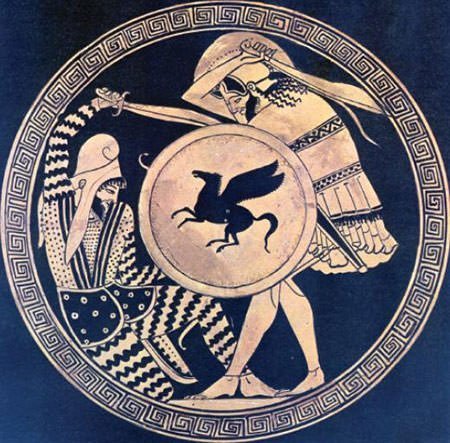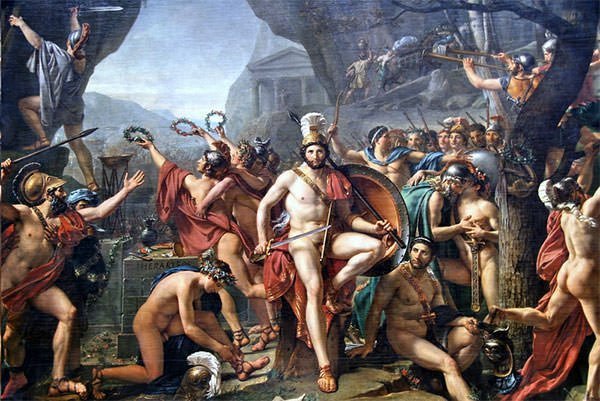Battle of Thermopylae is most famous for the last stand of 300 Spartans though it is not known by many that it also involved 1100 warriors from other Greek states. It was fought for 3 days in the year 480 BC and was part of the Second Persian Invasion of Greece led by Xerxes the Great. The Greeks chose the narrow pass of Thermopylae as the site of the battle in a brilliant strategic move and were able to hold the Persian army for 2 days before the Persians discovered an alternate route and were able to surround them. This led to one of the most famous last stands in history in which the Greeks led by Leonidas I of Sparta fought valiantly against the Persians but died to the last man. Here are 10 interesting facts about the causes, events and aftermath of the Battle of Thermopylae.
#1 THE MAJOR CAUSE OF THE BATTLE CAN BE TRACED BACK TO IONIAN REVOLT
The Greek cities in the region of Ionia in modern day Turkey came under the Persian Empire since 547 BC. In 499 BC, the Greeks in the region revolted in what is known as the Ionian Revolt. The Greek city-states of Athens and Eretria supported the Ionian Revolt during which parts of the region were burnt by the Greeks including Persian temples in the cities. Though the revolt was ultimately crushed by the Persians, Darius I, king of the Persian Empire at the time, vowed to punish those involved in it, especially Athens. This led to the First Persian Invasion of Greece in 492 BC involving the famous Battle of Marathon in which the Greeks decisively defeated the more numerous Persian army inflicting heavy casualties on them.

#2 PERSIAN EMPIRE WAS THE LARGEST IN ANCIENT HISTORY
The son of Darius I, Xerxes I, also known as Xerxes the Great, became ruler of the Persian Empire in 486 BC. He planned a massive invasion of Greece to avenge for the Persian losses in the Ionian Revolt and the Battle of Marathon. The Persian Empire at the time was the largest ever empire in ancient history stretching from the Indus river in Asia to the Nile river in Africa. Xerxes used his vast resources to assemble soldiers, build ships and buy supplies for his invasion of Greece.

#3 THE PERSIAN ARMY NUMBERED PROBABLY IN HUNDREDS OF THOUSANDS
Hellespont is a narrow, natural strait. Xerxes decided that the strait would be bridged to shorten his route to Europe. The resulting spectacular pontoon or floating bridges are considered feats of exceptional engineering which was beyond any other contemporary state. In 480 BC, the Persian army crossed over the floating bridges to reach Europe. Though ancient historians claim that the strength of the Persian army was in millions, modern scholarly estimates are generally in the range of 70,000 – 300,000. A fleet of about 1000 warships escorted this massive land army. Even by modern estimates, it was still one of the largest and most sophisticated army ever assembled for invasion in the ancient world.

#4 GREEK DEFENCE WAS PLANNED BY THEMISTOCLES
Greece around the time of the battle was a collection of small city states with a history of fighting against each other for regional supremacy. The largest of the city states, Athens and Sparta, were bitter rivals. In 481 BC, a confederate alliance of Greek city-states was formed to defend their land against the Persians. This was remarkable for the Greek world as many of the city-states were still technically at war with each other. Athenian politician and military general, Themistocles, who had been preparing for war by strengthening the Athenian fleet, primarily prepared the Greek strategy of defense against the Persians.

#5 THERMOPYLAE’S SELECTION AS BATTLEFIELD WAS A GREAT STRATEGIC MOVE
To defend against the Persian invasion, the Greeks brilliantly chose the narrow coastal pass of Thermopylae to nullify the numerical advantage of the Persians. It is believed that the Thermopylae pass at the time was only 200 yards at its widest and so the Persians had to come through it in small numbers which could be countered by the relatively small Greek force. Also their cavalry would be rendered useless. Themistocles understood that the Persian navy could sail through the Straits of Artemisium to reach behind the Greek ground force and surround it. Thus, to block the strait, he positioned there an allied Greek navy of which he was the de facto commander.
#6 GREEKS WERE LED AT BATTLE OF THERMOPYLAE BY LEONIDAS
At the time of the Persian invasion, the Spartans were celebrating the festival of Carneia and were forbidden from military activity. Ancient historian Herodotus reports that Spartan king Leonidas consulted the sacred Oracle of Delphi who said that either your town would be sacked or it would mourn the loss of a king. Leonidas believed he was that king and agreed to lead the Greek defence at Thermopylae. He chose 300 Spartans with living sons to make sure their bloodline was not terminated. Along the way his army was reinforced by contingents from various Greek cities and by the time it reached Thermopylae it numbered around 7,000.

#7 PERSIANS FAILED TO MAKE ANY HEADWAY IN THE FIRST TWO DAYS
In August or September 480 BC, the Persian army of Xerxes the Great met the Greek allied force led by King Leonidas in the Battle of Thermopylae. The Persians attacked the Greeks in waves of around 10,000 men but failed to make any headway during the first two days of the battle. These attacks included attacks by the elite force of Persian soldiers known as The Immortals. At the simultaneous naval Battle of Artemision, a Persian fleet of around 1000 warships was up against a Greek fleet of 200 warships. There too the Persians failed to make any headway. They sent 200 warships to reach behind the Greek land force through a different, longer route but unfortunately for them they all drowned during a storm at night.

#8 THE GREEK USED THEIR FAMOUS PHALANX FORMATION IN THE BATTLE
At the Battle of Thermopylae, the Greeks used their famous Phalanx formation in which the men formed a wall of overlapping shields and protruded their spears out from the sides of the shields. The famous Greek shield known as Hoplon was heavier and stronger than their opponents, handing them an advantage. Their long spears known as Dory gave them more distance and force against their opponents’ smaller weapons. Also the Greek’s strong lamellar armor was able to withhold the Persian arrows and spears. The Persians wore light armor as they needed agility to fight in the open plains of Asia. Their armor, even of The Immortals, was easily pierced by the Greek Dory.

#9 THE FAMOUS LAST STAND INCLUDED 1400 SOLDIERS, NOT 300
After losing tens of thousands of his men in the first two days of battle, Xerxes had a stroke of fortune when a Greek named Ephialtes informed him of a mountain pass that would lead his men behind the Greek army. Ephialtes betrayed his homeland in hope of receiving a reward from the Persians. His name came to mean “nightmare” in the Greek language. Leonidas was aware of the mountain pass and had placed a force of 1,000 Phocians to guard it but they withdrew thinking incorrectly that their homeland Phocis was under attack. When Leonidas came to know the he was being outflanked, he dismissed the bulk of the Greek army. The only remaining soldiers to guard their retreat were 300 Spartans, 700 Thespians and 400 Thebans. Thus the Greek’s last stand at Thermopylae involved around 1400 men and not 300 as is popularly proclaimed and portrayed.

#10 THOUGH PERSIANS WON THE BATTLE THEY COULDN’T CONQUER GREECE
With the Persians surrounding the Greek army, the Phalanx was broken and there was open battle. In one of the most famous last stands in history, Leonidas and his men fought valiantly against the Persians but died to the last man. It is said Leonidas died after being struck from an arrow. Although Persians were known for treating valiant warriors with great honor, Xerxes was so outraged at his losses that he ordered that the head of Leonidas to be cut off and his body crucified. The simultaneous naval Battle of Artemisium ended as the Greeks withdrew after their defeat at Thermopylae. Xerxes went on to burn Greek cities to ground as he had desired, though most of the people were evacuated. The Persians were crucially defeated in the naval Battle of Salamis in late 480 BC and then decisively in the land Battle of Plataea in 479 BC, thus ending the Second Persian Invasion of Greece.

300 (2007 MOVIE) ACCURACY
Released in 2007, 300 was a commercially successful movie based on the Battle of Thermopylae. The film used figures and accounts given by ancient Greek historians which are considered to be inaccurate by most modern historians. But it is not the inaccuracies that disturbed most of its critics as they could be due to the purpose of entertainment and as part of artistic liberty. What was heavily criticized by several scholars was its polarizing portrayal of the democratic, good and rational West versus the tyrannical, evil and irrational East. Canadian academic lecturer Kaveh Farrokh notes that “The founder of the Achaemenid (Persian) Empire, Cyrus the Great, was the world’s first emperor to openly declare and guarantee the sanctity of human rights and individual freedom”.


I enjoyed reading about the Battle of Thermopylae. I learned a number of interesting facts, thank you for the history.
You’re welcome.
I think it’s because back when they were alive they didn’t have much real clothes like we gave today
why are all the gods naked